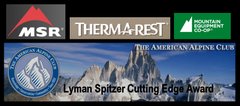Sep 27, 2007
The Outside Penguin Teaser
Aug 30, 2007
The Outside Penguin
New Route: The Outside Penguin (V: 5.10, A1) in the Latok Group,
The summer of 2007 of the Karakoram was unusually wet, thwarting most attempts at climbing. Backed by the AAC’s Lyman Spitzer Award and Mountain Equipment Co-op, our original objective was the unclimbed feature just under and southwest of Latok II (7108m; see below). We facetiously named this gargantuan gendarme “Latok II¾” (~6500m); its southwest face presents a 1500m wall of near-vertical, unclimbed granite. With all the bad weather, this normally rock climbable objective was shrouded in verglas and powder, rendering it too full on for the likes of us.


Seven hundred meters up the face, we hoped for a quick, sun-bathed dash for the summit on Day 2. Instead, threatening skies and false summits made for a more Blue-collar finish. After soloing up moderate terrain past the false summits, we reached the base of the third and final headwall. A long, broken pitch led to a steep cirque with no obvious line of weakness, where our streak of luck appeared to end. Straight up presented thin, vertical cracks; to the left stood a complex prow blocked by an overhanging wart of granite; the right was blocked by a crackless buttress and an overhanging rotten ice gully. Ken scouted the right options, launching into ledge-fall potential on an unprotectable face. He wisely retreated as the difficulty ramped up. Next, I tried the left prow. By stemming past an ice-chocked corner, I reached the base of the overhung wart, where our luck returned. A moderate ramp allowed us past the previously hidden side of the gendarme, beyond which the crux pitch gave way to the wart’s top. Ken then led two mixed pitches with our one pair of crampons to the summit, as snow began to fall.

Aug 14, 2007
The Karakoram Highway (KKH)
Aug 11, 2007
Islamabad-bound
Aug 5, 2007
Expedition Draws to a Close
Last night, we arrived in Skardu (Pakistan's version of civilization) after a speedy retreat from basecamp. All team members are safe and happy and finally showered. What follows is a brief summary of our expedition.
July is usually the best month for climbing in the Karakoram but this year's July was, quite simply, horrible. We had 7 days of good weather to 19 days of poor weather. Latok II-3/4 was all snowed up and would not be feasible. After acclimatizing, we turned our attention to the northwest ridge of Latok II (7108m). The ridge involved a complex mixed or ice climb (two different ways up) to a col at 5900m followed by 12oom of average 45-degree snow and mixed narrow ridge crest, with some difficult, steeper rock steps. Jeremy decided to stay back as Ken, Sam, and Ryan made an attempt via the mixed approach. Sam took a 20-foot lead fall when his tools popped out of snow-ice. The sun came out strongly, and the altitude hit Ryan and Ken especially. With altititude symptoms, the boys retreated to ABC at midnight.
Upon returning to basecamp, the weather was holding so another attempt was considered. This time, Ken decided to stay back due to his altitude sickness low down. He would have needed more time than was available in order to acclimatize properly. Sam and Ryan thus made a second attempt, this time taking the ice approach to the col. They then spent 2 days at the col in blowing, snowing conditions before retreating in light of more on-coming weather.
Meanwhile, Ken and Jeremy approached a 1200m rocky south face of an unnamed, unclimbed peak. They climbed 20 pitches in total along with much simulclimbing and soloing. Over the course of 1.5 days, they reached the summit of what they dubbed "Karim Peak" after our legendary and eccentric guide named Little Karim. The planned descent turned out to not be feasible and so they retraced their way down the whole route, rappelling some 800m over the course of 1.5 days. Along the way, they were caught in a ferocious storm and spent an uncomfortable night huddled under a tarp as the snow flew. (In the end, Jeremy slept for a total of 1 hour on the the climb.) Now into the rain, Ken and Jeremy rappeled and rappeled, eventually reaching the base, cold, wet, but happy. They named their route "The Outside Penguin" (V: 5.10-, A1).
Upon returning to basecamp, we received another poor forecast from KiwiJay and so decided to retreat early. The glacier walk from basecamp had been grippy on the way up. After 3 weeks of near constant rain, it had been transformed into an ice rink making for a fast but exciting retreat. Yesterday, we walked/slid for about 30km before hopping in a jeep and bouncing along for 5 hours. We all enjoyed sleeping last night very much.
Next, we plan on staying in Skardu for 2 days before having a leisurely hiking tour of Little Karim's home, in the Hushe Valley. Including transport, it will be a 4-day journey.



